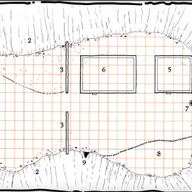1. Caravan Trail: This narrow trail leads to the open Ivory Plain and is carefully marked and kept clear of debris by the outpost garrison. The trail is hard-packed earth, and is wide enough for one mekillot wagon to pass through. The trail ends in a large open area outside the wall, where visiting caravans camp.
2. Canyon Walls: These high cliff walls protect Outpost I9 from the winds and sandstorms of the desert. The canyon entrance twists and turns before reaching the open salt flats, further protecting the outpost. The canyon walls rise some 200 feet above the outpost and are beautifully colored with bands of various shades running horizontally along the canyon. The lower reaches are scalable, but much of the cliff face is very steep, and thus far no one has successfully climbed up to the top (or down from above). The terrain at the top of the cliffs is unknown; no one has ever managed to approach the outpost from any direction other than the caravan trail.
3. Wall: This low stone wall represents the primary line of defense for the outpost. While the wall is high enough to discourage jumping over it on crodlu-back, it is low enough to see over and can easily be scaled by a normal human. (Thri-kreen can leap over this wall with ease.) Notches have been set into the top of the wall to allow arrows to be fired at any attackers.
4. Aarakocra Aerie: The top portion of the cliff wall in this section is strung with a complex structure made of netting. This netting is home to a tribe of aarakocra that hunts across a wide range in the Mekillot Mountains. The aarakocra have been here since Outpost 17 was reconstructed, but all attempts to contact and ally with the birdmen have failed. The aarakocra occasionally steal an erdlu when times are hard, but otherwise avoid all contact with their neighbors below.
5. Housing: This building contains the living quarters of the traders and garrison of the outpost. It is partitioned into a number of smaller rooms; Ragstol, Astemba, and Mersten Vell have rooms of their own, while the remaining staff are distributed three to a chamber. A common chamber acts as a dining hall and workroom.
6. Trading Warehouse: This wooden building, the largest in the compound, contains the trade goods which Ragstol and the other traders buy and sell. More often than not, the building is more than half empty, as the warehouse was built in expectation of a much higher volume of trade. Now and then, however, large caravan drops are made by House Wavir, which ships the goods from South Ledopolus or Altaruk to Outpost 13. These are then doled out to visiting caravans over a period of months.
7. Well: This small well is a wide shaft that drops some 30 feet to the water below. The water is tangy with minerals, but is safe to drink. Water is drawn up by throwing waterskins into the well, then hauling the skins up by ropes. Lifting the water is hard work, especially since the water must be lifted for the erdlu and crodlu as well as for all the humans. Mersten Vell often assigns drawing up water as a punishment for unruly behavior. This well is the only supply of water in Outpost 19. As a result, it is not practical for caravans to remain here for more than a day or two. The demand placed on the well by watering the animals and staff of a typical caravan in addition to the permanent outpost garrison will quickly deplete it. Caravans knowledgeable of the region are aware of this and bring the minimum number of animals up the canyon to the outpost. New caravan masters are quickly informed of the situation by Ragstol on their first visit.
8. Animal Pens: These pens contain the outpost's herd of 40-60 erdlu and crodlu. These flocks are used as mounts for the occasional expedition, trade goods for the caravans, and food bribes or raiding thri-kreen, so the number of animals in the fortress varies wildly. These animals are replenished by caravans and by the slaves of Salt View, for which they are almost the only export.
9. Cave: This low chamber is used as a secondary storeroom or as a living chamber when visitors exceed the capacity of the outpost's small buildings. It is 20 feet deep, roughly circular, and has a 15-foot ceiling. At the rear is a narrow tunnel, 4 feet in diameter, which leads off into darkness. The small tunnel was sealed off when the outpost was built to avoid a visit from some hibernating creature
